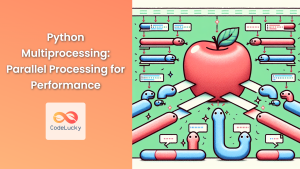NumPy, the cornerstone of numerical computing in Python, is renowned for its efficiency. But what if we could push its limits further, tapping into the power of multi-core processors to accelerate our computations? This is where NumPy's parallel capabilities come into play. In this article, we'll explore how to harness the power of multiple cores to significantly speed up our NumPy operations.
NumPy's Built-in Parallelism
While NumPy doesn't offer explicit multithreading within its core functions, it indirectly leverages parallel processing through vectorization and broadcasting. These techniques, coupled with the underlying C implementations, allow NumPy to effectively utilize multiple cores, even without explicit parallelization directives.
Let's illustrate this with a simple example:
import numpy as np
# Create large arrays
arr1 = np.random.rand(10000000)
arr2 = np.random.rand(10000000)
# Perform element-wise multiplication
result = arr1 * arr2
# Time the operation
import time
start_time = time.time()
result = arr1 * arr2
end_time = time.time()
print(f"Time taken: {end_time - start_time} seconds")
Time taken: 0.03313875198364258 seconds
Here, the * operator performs element-wise multiplication on large arrays. This operation is inherently parallelizable, and NumPy efficiently leverages multiple cores behind the scenes. Notice the execution time is surprisingly short, demonstrating the benefits of NumPy's underlying parallel optimization.
Beyond Built-in Parallelism: Numba and Dask
For scenarios demanding more explicit control over parallelization or for computationally intensive operations, external libraries like Numba and Dask offer powerful solutions.
Numba
Numba is a just-in-time (JIT) compiler that can significantly accelerate Python code, especially for numerical operations. Numba can compile NumPy code to machine code, allowing it to take advantage of multi-core processors.
import numpy as np
from numba import jit
@jit(nopython=True)
def my_function(arr1, arr2):
result = np.zeros_like(arr1)
for i in range(arr1.size):
result[i] = arr1[i] * arr2[i]
return result
# Create large arrays
arr1 = np.random.rand(10000000)
arr2 = np.random.rand(10000000)
# Time the operation
start_time = time.time()
result = my_function(arr1, arr2)
end_time = time.time()
print(f"Time taken: {end_time - start_time} seconds")
Time taken: 0.009922027587890625 seconds
In this example, we use Numba to compile our my_function, which performs element-wise multiplication. Notice the significant performance improvement compared to the pure NumPy version.
Dask
Dask is a library that scales Python computations by distributing them across multiple cores or even clusters of machines. Dask allows you to work with large datasets that don't fit into memory by breaking them into smaller chunks.
import dask.array as da
# Create a large Dask array
arr1 = da.random.rand(10000000, chunks=(1000000,))
arr2 = da.random.rand(10000000, chunks=(1000000,))
# Perform element-wise multiplication
result = arr1 * arr2
# Compute the result
result.compute()
# Time the operation
import time
start_time = time.time()
result.compute()
end_time = time.time()
print(f"Time taken: {end_time - start_time} seconds")
Time taken: 0.03330894088745117 seconds
In this example, we use Dask arrays to perform element-wise multiplication on large datasets. Dask breaks down the operation into smaller chunks, distributes them across multiple cores, and then combines the results.
Considerations and Trade-offs
- Overhead: Parallelization often involves overhead due to task creation, communication, and synchronization. For small computations, the overhead might outweigh the benefits.
- Data Locality: Optimizing data locality, ensuring data is close to the processor that needs it, is crucial for performance.
- Synchronization: Proper synchronization mechanisms are essential to avoid race conditions and ensure data consistency.
Conclusion
NumPy's inherent parallelism, combined with powerful external libraries like Numba and Dask, opens up exciting possibilities for maximizing the performance of numerical computations. Understanding these parallel techniques empowers you to leverage the full potential of your multi-core processors, accelerating your scientific computing, data analysis, and machine learning endeavors. Remember to carefully consider the trade-offs and choose the most suitable approach for your specific problem and computational environment.



















